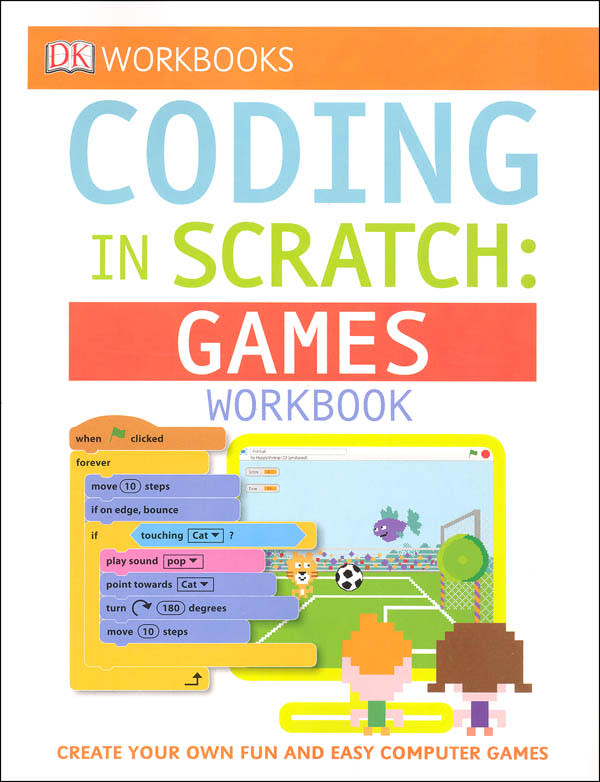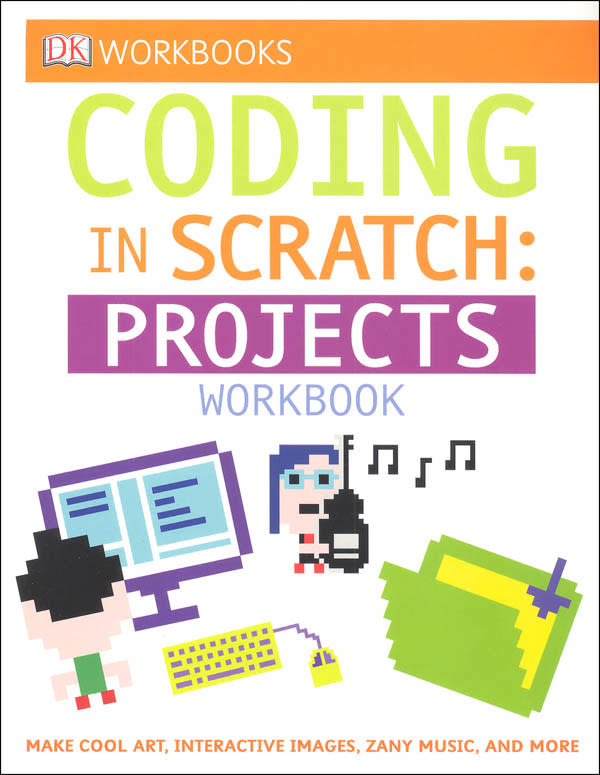Scratch is a free, simplified programming language for children that was created by folks at the Massachusetts Institute of Technology. Scratch is also an online community where kids can share their games, animations, and other projects they create with Scratch. You can find Scratch at https://scratch.mit.edu/. Information on Scratch itself is on the last page of each book.
Scratch can be used online, or it can be downloaded to use without an internet connection. Both options are free. The Scratch website has a guide and some project ideas, but DK has created two inexpensive workbooks titled Coding in Scratch that help users become familiar with Scratch while also walking them through step-by step creation of games and projects.
One workbook is subtitled Games Workbook while the other is Projects Workbook. Those new to Scratch can begin with either workbook.
Scratch teaches users how to code, but in a simplified fashion. It uses blocks that fit together in particular ways rather than requiring users to first learn a detailed coding language. Users need to get familiar with the Scratch editor, but it’s relatively simple. Of course, projects are limited in their complexity by the limitations of Scratch. Nevertheless, this is an easy way for young people to get started with coding.
Both books begin with an introduction to Scratch itself. “Show What You Know” sets of questions at the end of each project check for comprehension and understanding. Students should write their answers to these questions directly in their workbooks. A few questions direct users to try out their ideas in Scratch to test their understanding. Answer keys are at the back of each workbook.
After the introduction to Scratch, each workbook walks users through specific projects. The Games Workbook has them create four games: Fishball, Ghost Hunt, Rapid Reaction, and Melon Bounce. Games are relatively simple, but once users learn the basics, they might well have the confidence and motivation to learn how to create more complex games.
The Projects Workbook stretches different directions with five projects that introduce users to many more capabilities of Scratch. Weird Music teaches how to make music and create sprites. Skywriting teaches how to create patterns, messages, and pictures; how to use if-then blocks; how to spray splotches onto the stage; and how to create color effects. In Quiz Time! users learn how to create their own automated question-and-answer quizzes. Pet Party teaches how to draw sprites with the paint editor, how to load your own pictures to use in a project, how to trigger scripts, and how to load sounds. The student should load a picture of his or her pet into the program for this project. Bounce Painting teaches how to have the program draw lines whenever a sprite moves, filling the stage with various colors. You can see how the various projects develop familiarity with various tools and ways to combine blocks.
The workbooks are only 40 pages in length, so they are very manageable. Full-color and loads of illustrations make the books attractive as well as easy to follow. Students can see exactly what they are supposed to do, although they do get to make some of their own choices to personalize their projects a bit.
I think parents who know nothing about coding themselves will find these workbooks a great way to introduce this skill to their children without having to learn it themselves.










